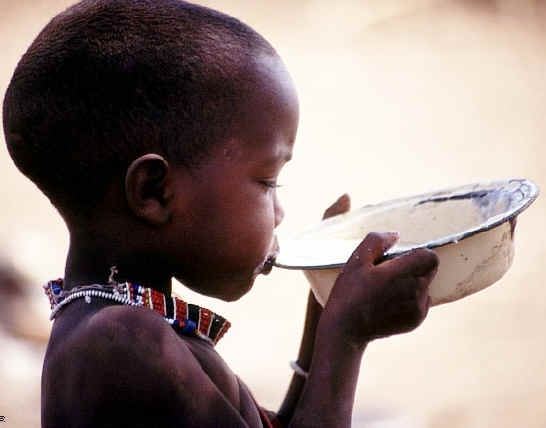Will the National Population and Housing Census change Kenya’s current situation?
Jan 21, 2015
Story



As she clutches protectively onto her plastic bowl containing her day’s meal of white lumpy porridge, Nelima is oblivious of where her next meal will come from. The 3-year-old does not know her mother’s daily struggles to put such a meal on the table at the end of the day. She does not know what her mother goes through to deliver this. Looking at her together with her five siblings dig in to the porridge greedily makes one think seriously about the worsening famine cases in the country. Little does she know about the much awaited National Population and Housing Census later this month which is supposed to help the government ‘plan’ for every living member in the country. Dressed in tatters and residing in Mathare slums, her innocent mind knows nothing about whether her existence is important to the government or not. This life of poverty is not unfamiliar to her either.
Current situation
Kenya is currently crippled with several setbacks, which puts the government on the spot on whether the coming population census will change the situation any sooner. The rising food shortages coupled with sky-rocketing food prices cannot go unmentioned. Currently, it is estimated that 10million Kenyans face severe starvation, which is close to a third of Kenya’s 36 million people. The most affected groups include about 1.5 million children, 3.2 million people who live in drought prone areas, about 2.5 million vulnerable Kenyans suffering from various diseases including HIV/AIDS, orphans, and another 2.5 million categorized as the urban poor.
The situation has left many families like Nelima’s, toil harder to be able to afford a day’s meal. Many families for instance have resorted to only one meal a day, including the children. The short rains expected in Kenya in the end of 2008 failed, and the long rains, expected in April, were like a drop of water in the ocean. This has led to extremely low harvests. Post poll chaos in 2007 that led to millions being displaced is also part of the reasons why food insecurity has been on the rise. According to the Kenya National Bureau of Statistics, food prices have increased by 33% within the last year. Many families are turning to unimaginable coping mechanisms to be able to survive the biting hunger. In several parts of Kenya especially those that lie in the arid and semi arid lands like Eastern and North Eastern provinces, the people have not seen a drop of rain since last year. Hence the persistent drought has led them to having meals like boiled mangoes and paw paws. Some families from the north eastern parts of Kenya are eating anything in sight including wild fruits, rats, bitter herbs, anything! There are even reported cases of people eating donkeys, monkeys and baboons, having come in handy as a cheap alternative to usual red and white meat. In the past, such creatures were never looked at as food.
The Ministry of Agriculture recently admitted the serious food shortage, saying several measures are being laid down to put the situation under control.
Water shortage
The country is also experiencing serious water shortage. It is estimated that two thirds of the country’s population is facing water shortage. This has affected smooth running of most operations in the country. The government has so far resorted to rationing this rare commodity in the country’s capital city, Nairobi, with most residential areas going for months without water. Currently, a 20-litre jerrican of water from vendors is trading between Kshs 100-150 (US$ 1-2). And you can guess the pressure that this is putting on urban households, bearing in mind the harsh economic times. Some boarding schools in Nairobi for example, had to break a bit earlier for holidays because of the water shortage because some were spending more than Kshs. 5,000 daily on water. Most schools have shunned vocational tuition for this reason too. Hotels and restaurants have also had their share, having to spend more on water hence affecting their prices.
Even the government’s recent proposal on school feeding programme for children facing extreme hunger and poverty during the holiday is also questionable, bearing this in mind. The campaign dubbed Together for Child Vitality, which is to be done jointly with World Food Programme, Unilever and the government, is to be implemented in 65 schools in Nairobi and Narok district in which 25,000 children are to benefit.
Water shortage has also resulted in high cases of cholera in the country. Currently, about 2063 cholera cases have been reported with 37 reported deaths, according to United Nations Office for Coordination of Humanitarian Affairs (OCHA) Kenya. Children are the most vulnerable to this condition.
Power shortage
Blackouts are now a constant feature in all parts of Kenya, including Nairobi’s Central Business District. This is as a result of insufficient rainfall that has severely reduced water levels in Kenya’s dams, that generates two thirds of the country’s power through hydroelectricity generation. The government officially started power rationing for the whole country, with each section getting electricity only for four days of the week. You can guess the nightmare of businesses like salons, internet cafes, among others, which rely heavily on electricity. Imagine how much the country is losing in terms of growing the economy with a shortage of these important commodities. . .
The 2009 Population and Housing Census
The national census which is scheduled on 24th/25th this month is to help the government get evidenced data to be able to plan for its population. The census which is usually done at the interval of ten years, is to give statistics on the size, distribution and composition of a population to help the government carry out development planning and in making administrative and policy decisions. This will be Kenya’s 7th census.
But the begging question is… does the census achieve its objectives? Will the data collected be able to solve some of the country’s outstanding challenges? Will children like Nelima be able to access the basic needs as a result of well-planning?
An interview with most of the population reveals that a majority of the people feel that the exercise is a waste of time and resources. ‘Nothing has ever changed in my life since the last enumeration,’ were some of the responses. Some are actually looking for all means not to be counted. With this year’s motto reading as ‘Niko. Natambulika (The Kiswahili for ‘I am here. I am to be known’), a majority are not seeing sense in being ‘known’ yet the living conditions are grave. ‘This is like mocking us. Do we only exist to be counted, in terms of votes?” poses Catherine Nguli, a vegetable vendor.
The data is also said to be important in determining resource distribution. But this poses another challenge on credibility. Last year, the Kenya National Bureau of Statistics (KNBS), which is the same body carrying out the census, released some data about poverty rates per region in the country. This data was to be used by the government in the distribution of Constituency Development Fund (CDF). But the data came under sharp criticism on the accuracy, with most people including the Minister for Planning accusing it of being ‘inaccurate’ and ‘biased’. With such loopholes and doubts on the government data, one wonders whether the population census data will be any accurate, to be able to achieve the intended goal of resource distribution.
Hence as the government engages in its usual political bickering, such grave issues affecting the country should top their list. They should ensure that the population census is not a mere formality because the government is spending tax payer’s money of up to Kshs 7.4billion. The evidenced data obtained should be able to make Kenya a better place for Nelima and the rest of the population. Food security for instance, proper health and medication, more job opportunities, access to clean water and sanitation, proper housing for all, just to mention but a few. These are some of the begging issues that the government should look into as they seek to obtain this important data that only happens once in ten years.




